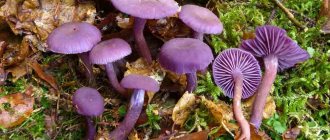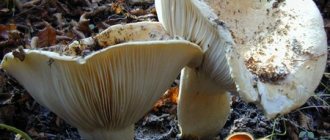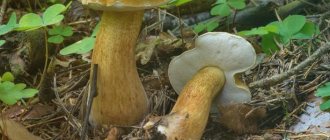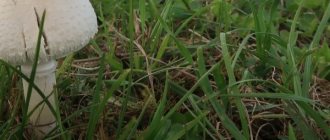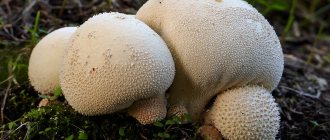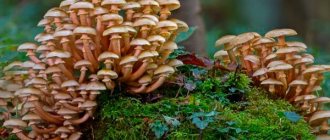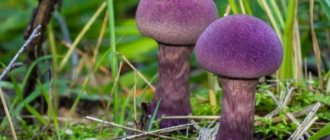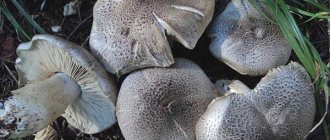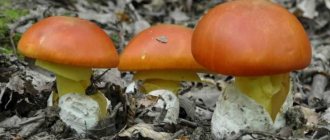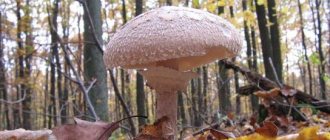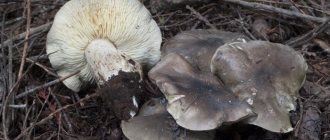Amethyst varnish attracts attention with its unusual color, which is why it received its name. The flesh also has an amazing color, although it is lighter. Not only color helps to distinguish this mushroom from others. There are a number of external features that make it possible not to confuse it with false doubles. Only by carefully studying the information about the varnish can you understand whether it is edible and how to prepare it correctly.
Description of the mushroom
The Latin name of the amethyst lacquer is Laccaria amethystina.
Because of its special tone, it is also popularly called Lakovitsa lilac or violet. This species belongs to the family Oryadovaceae, genus Lakovitsa. The color of young fruiting bodies is very rich. Mushroom caps initially have a hemispherical shape, which, as they ripen, straightens and acquires a smooth surface. There is a barely noticeable scar on it and whitish streaks are visible along the edge. The fruit body is small, the cap grows in diameter from 1 to 5 cm.
Underneath it are thin, sparse plates of the same color, which become lighter when the spores mature. They grow together with the stalk, on which the longitudinal fibers are clearly visible. This part is hollow inside and has a diameter of no more than 8 mm. The height of the leg is from 3 to 10 cm. Its color is slightly lighter than that of the cap.
White fungus spores. The pulp is thin. Like the outer part of the mushroom body, it has a purple color.
A little history
Laccaria amethystina has been collected and used as food by people since ancient times. Its description was first made in 1778 by the English botanist and apothecary William Hudson. He classified the mushroom as champignons. Much later, this species was assigned to the Oryadaceae family.
Answers to common questions
What dishes can be prepared from purple mushrooms?
They are used to make salads and pie fillings. Since they do not have a strong odor, it is not advisable to cook hot dishes from them. The product can also be pickled and salted.
How long can cut mushrooms be stored?
The cut product can be stored in the refrigerator for no more than 3 days. However, if you store it at room temperature, then the count is not for days, but for hours. At room temperatures above 10, the shelf life is reduced to 12 hours.
Can you get poisoned by purple mushrooms?
Yes, there is a possibility of poisoning. To avoid poisoning, you need to beware of poisonous lookalikes and fruiting bodies that grow in industrial and contaminated areas. This limitation exists due to their ability to absorb all toxins from the environment and soil.
Mushrooms with a lilac color are bright representatives of their kingdom, which attract lovers of “quiet” hunting with their exotic appearance. But they not only have a bright and memorable color, but also many useful properties that are used both in folk and evidence-based medicine, as well as in cooking.
Where and when does it grow?
Lilac varnish grows in moist soils that contain a high concentration of nutrients in an easily accessible form. It is usually found in deciduous forests, most often next to oaks or beeches. Less commonly, the species is found among coniferous trees.
Lakovice is common in European countries with temperate climates. In some regions of North America, where the species also grows, it may be imported. In Russia, this mushroom is especially common in the Kaluga and Smolensk regions.
The fruiting period lasts from July to October. The maximum number of fruiting bodies occurs in September. In hot weather, their numbers decrease, and the color of the mushrooms becomes pale and faded.
Important! During drought, the taste of the mushroom is significantly reduced, and it is usually of no culinary interest.
Similar species
Due to its color variability, common varnish sometimes looks like meadow honey fungus. However, it is quite easy to distinguish them; the plates of the meadow honey fungus are painted white.
Lilac lacquer
Another similar mushroom. This similarity is not always revealed, but only during dry periods, when both types of lacquer fade. Lilac lacquer can be distinguished by its stem, which is thinner. However, an error in identification does not play a role here - the culinary qualities of both mushrooms are identical.
- https://gribnikoff.ru/vidy-gribov/sedobnye/lakovitsa-ametistovaya/
- https://fermilon.ru/sad-i-ogorod/griby/lakovitsa-ametistovaya-lakovitsa-lilovaya-opisanie-i-foto.html
- https://gribowiki.ru/eatable/lakovica-ametistovaya.html
- https://howtogetrid.ru/lakovica-ametistovaya-opisanie-gde-rastet-yadovitost-griba/
- https://gribowiki.ru/condit/lakovica-obyknovennaya.html
Is it worth growing Lilac varnish?
Amethyst varnish has quite good taste. If desired, it can be grown in a personal plot. The mushroom is not cultivated on an industrial scale, like champignons or oyster mushrooms.
- Planting requires the purchase of mycelium, which is usually sold in powder form. It is advisable to grow purple varnish under trees.
- Before planting, the mycelium in a volume intended for an area of 1 m2 should be mixed with 500 g of dry sand. Under the selected tree, remove the soil to a depth of 5 to 15 cm, depending on the location of the roots, and form a groove around the trunk. Its bottom is loosened. Then a mixture of mycelium and sand is evenly distributed over it.
- It is covered with a thin layer of fertile forest soil or garden soil mixed with humus in a 1:1 ratio. The planting is watered with a watering can or hose with a sprayer. It is necessary to pour 10 liters of water onto an area of 1 m2. After this, the groove is completely covered with the earth that was removed. Mycelium can be planted in this way from spring to early autumn.
- Caring for lilac varnish is simple. In dry times, the mycelium is watered in a volume of 20 liters per 1 m2. Feeding is required 2 times a year. It is carried out during periods when the formation of fruiting bodies does not occur. At this time, the planting area is covered with humus - 15 kg per 1 m2.
The mycelium will remain active as long as the tree near which it is planted grows. Therefore, it is worth choosing strong, young trees that do not show signs of disease.
At home, you can also try to grow a mushroom similar to champignons, but such an activity is much less productive and does not make much sense. Such an attempt can more be called an experiment.
Collection rules
Large varnishes do not have clearly defined habitat boundaries. They can grow close to other species. There is always space between individual specimens in a group, so collecting them is very convenient. You should carefully cut it at the root with a knife, or gently twist it out of the mycelium. You should not leave stumps: they will rot, infecting the entire system. The large varnishes are quite fragile. To bring the harvest home, the stems must be separated and the caps placed in a basket in rows, with the plates facing up.
Attention! Large varnishes tend to accumulate arsenic in their bodies, so they should be collected in environmentally friendly areas, far from highways, landfills and large industrial enterprises
False doubles
Like most edible mushrooms, purple lacquer has doppelgängers. It is easier to see the differences from the original in the photo.
A novice mushroom picker needs to know exactly what features a dangerous copy and an edible mushroom have:
- Mycenapura or pure mycena. A poisonous double that belongs to the category of hallucinogenic mushrooms. Its color is also lilac, but with a distinct brownish tint. Also a clear difference from the edible species is the presence of white or gray plates and a pungent odor of radish in the double.
Mycena pure - Gossamer violet. An edible double that can only deceive a novice mushroom picker. Distinctive features are the presence of a fibrous film under the cap and larger sizes.
Gossamer violet - Pink lacquer. An edible mushroom that has a light pinkish color and can be confused with the lilac type in drought when the latter turns very pale.
Pink lacquer
Important! In order not to be poisoned by false doubles, if you have the slightest doubt about the safety of the mushroom found, you must discard it.
Similar species, distinctive features from them
In appearance, the nearest varnish (Laccaria proxima) resembles the pink varnish (Laccaria laccata). True, this one has a perfectly smooth leg, which is why it is distinguished from Laccaria proxima by the absence of spines and scales.
Another mushroom similar to Laccaria proxima is called Laccaria bicolor. The plates of this mushroom have a purple color, which is uncharacteristic for a similar lacquer.
All varieties of varnish named in this article grow mixed in the forests of Russia. In drier areas, bicolor and pink lacquers grow, but Laccaria proxima prefers to grow in marshy, swampy and damp areas. A distinctive feature of large varnishes is that they do not spread over the ground like a continuous carpet, so when collecting, the mushroom picker will not trample them. The main distinguishing feature of this type of mushroom is the rough stalk, as if cut with a knife. When you feel it, you get the impression that some would-be mushroom picker simply didn’t finish the job.
Evaluation of taste qualities, medicinal properties, benefits and possible harm
The taste of the mushroom is pleasant, and the aroma is pronounced and not sharp. Due to the small size of the fruiting bodies and the small volume of pulp in them, lacovica is usually prepared in combination with other forest fruits, among which its taste is lost.
Mushroom is good for health. The positive properties of amethyst varnish are:
- improved digestion;
- maintaining cardiovascular health;
- increased hemoglobin content in the blood;
- removal of toxins from the body;
- increasing the strength of tooth enamel;
- strengthening the organs of vision;
- lowering blood cholesterol levels;
- getting rid of excess weight.
The composition contains a large amount of vitamins, macro- and microelements and dietary fiber, which determines the health benefits of the mushroom. At the same time, it also has contraindications for use.
The varnish can cause harm to the body in the following cases:
- operations on the intestines performed less than a month ago (due to the nature of the absorption of any type of mushroom);
- exacerbation of gastritis and peptic ulcer of the duodenum or stomach (due to increased load on the gastrointestinal tract during digestion);
- colitis – dietary fiber will irritate the intestines;
- pancreatitis - the fungus increases the secretion of bile, which is unacceptable for this disease.
Important! Even in the absence of contraindications, mushrooms can cause dangerous poisoning if they are collected in an environmentally unfavorable place.
What is Lion's Mane?
Scientifically known as Hericium erinaceus, Lion's Mane is an edible mushroom that has been widely used in traditional Chinese and Japanese medicine for centuries due to its medicinal properties.
You may have encountered it before under one of its other names, such as: Bear's Head
- Hedgehog Mushroom
- Hou-tou (Chinese) / Houtou
- Monkey's mushroom
- Old Man's Beard
Yamabushitake (Japanese) / Yamabushitake
What does Lion's Mane do?
Lion's Mane mushroom is naturally rich in several vitamins and minerals, and also contains some completely unique substances, including compounds such as erinacins, erinacin lactones, glycoproteins, hericerins and polysaccharides (beta-glucans). These bioactive compounds are believed to be the substances responsible for many of Lion's Mane's beneficial effects. The long list of benefits (which we'll explore in more detail below) includes:
- Anti-aging
- Antibacterial effect
- Antitumor effect
- Fighting fatigue
- Antioxidant effect
- Improvement of cognitive functions
- Neuroprotective effect
- Hepatoprotective effect
- Glucose-lowering effect
- Reduced anxiety
- Reducing inflammation
- Protection against stomach ulcers
- Immune System Support
Effect on nerve growth factor
While Lion's Mane has a long list of varied effects, it has recently gained significant popularity as a nootropic when it was found to affect nerve growth factor (NGF), a protein vital to the function and survival of nerve cells. Lion's Mane has been shown to increase the amount of nerve growth factor in the brain and improve cognitive properties by increasing neuronal growth, reducing inflammation, and supporting overall brain health.
Suffice to say, Lion's Mane is an incredibly intriguing and unique nootropic that can be a valuable addition to any supplement regimen to improve brain function. Now let's take a little deeper look at the many benefits this mushroom has.
Cooking recipes
Lakovitsa is excellent for heat treatment, freezing and making pickles. It can be dried without loss of taste, and the preliminary preparation of mushrooms is minimal.
Primary processing
- The collected mushrooms are sorted, removing debris and wormy fruiting bodies, and then washed in cold water in a basin.
- Afterwards, they are left to soak for 20–30 minutes, removed from the water and cleaned, removing pieces damaged by slugs from the caps.
- Whether or not to cut mushrooms depends on how they will be cooked. It is better to dry and freeze fruits whole.
Cooking
Boiled mushrooms are consumed with sour cream or vinegar; they can also be frozen. Boil the product in salted liquid (water should cover the fruiting bodies by 2 fingers) for 15 minutes. Then drain in a colander.
Freezing
Only those fruiting bodies that were collected no more than a day ago should be frozen fresh. They are washed and placed tightly in freezer bags, after which they are stored. In this form, the varnish retains its qualities for 6 months.
Boiled mushrooms are left to drain for 30–40 minutes before freezing. Once completely cooled, they are also put into bags and placed in the freezer. They can be stored for up to 4 months.
Frying
Fry boiled mushrooms in butter or vegetable oil. For preparation you will need:
- boiled mushrooms – 500 g;
- butter or vegetable oil – 1 tbsp. l.;
- dill – 20 g;
- 1 small onion;
- sour cream – 2 tbsp. l.;
- flour - 1 dessert spoon.
Sequencing:
- Heat the oil in a frying pan.
- Add the mushrooms and fry until golden brown.
- Add onions, herbs and sour cream.
- Simmer for 10 minutes.
- Add flour.
- Cook for another 5 minutes.
Pickles
Ingredients:
Step-by-step preparation:
- mushrooms – 1 kg;
- garlic – 6 cloves;
- horseradish root – 1 pc.;
- dill – 50 g;
- onion – 1 pc.;
- salt – 2 tbsp. l.;
- sugar – 1 tbsp. l.;
- vinegar - 3 tbsp. l.;
- bay leaf – 2 pcs.;
- black pepper – 5 peas.
Preparation:
- Chop the mushrooms and place in a wooden, plastic or enamel bowl.
- Add garlic, chopped horseradish, dill and onion.
- Mix salt and sugar.
- Pour this mixture over the mushrooms and stir.
- If desired, add bay leaf and black pepper, pour over vinegar.
- Install oppression.
- Place the pickling in a cool place.
The varnishes release juice after 3 days, and you can eat them after 4 days.
Drying
It is more convenient to dry the varnish in a dryer using a special mode, which should be indicated in the instructions for the equipment. If there is no dryer, then the fruiting bodies are strung on a thread and hung in a well-ventilated place where it is dry and does not receive direct sunlight. Store in linen bags in a dry place.
Amethyst varnish is an edible mushroom that can be grown in a summer cottage by planting its mycelium. He is undemanding about the type of tree of his partner and feels good around fruit trees. Eating amethyst varnish is good for health. When frozen or dried, the mushroom does not lose its qualities.
Information sources
Serzhanina G.I. Hat mushrooms of Belarus. - Minsk: Science and Technology, 1984. / Gribi Khmelnichchini. Chief assistant. Govorun V. D., Tymoshchuk O. O. - Khmelnitsky: Polygraphist-1, 2014. - 176 p. - P. 34. / E. Lawrence, S. Harniess Mushroom and other fungi. Identification guides British & European. // Flame tree publishing. London, 2007. - 384 p. - P. 174.
How to fry purple-footed row, recipe step by step at home
Bluelegs can be prepared in different ways. Frying mushrooms can be either served as a separate dish or combined with potatoes, porridge, vegetables and berries. The choice in favor of the best option is given based on the taste preferences of the housewife and household members. For example, frying potatoes with mushrooms involves cooking two ingredients in different frying pans. Subsequently, the products are combined and served as a single dish with sweet and sour sauce and fresh vegetable salad.
I use vegetables and berries separately, as a dressing or refried. If you decide to cook a vegetable stew, the cook fry the mushrooms and vegetables separately, combining them into a single dish, as in the case of potatoes. If preference is given to berries, use only the juice, adding it as a dressing to the prepared dish.
For 1 frying pan, 350 g of purple stem row is enough to later combine with a side dish.
